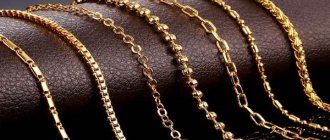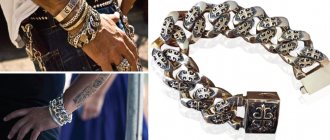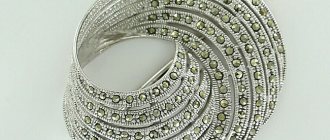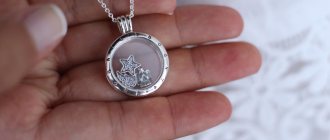History of the appearance and name of Bismarck weaving
Weaving appeared less than a century ago in Italy and initially spread under the name “garibaldi.” Many jewelry makers tried to take credit for it, but who exactly invented it remains unknown.
Among jewelers, there is a legend about a popular craftsman who was a fan of the first Kaiser of Germany, Otto von Bismarck, admiring his strong character, unbreakable political ties and steadfastness in matters of principle, he created such an original, durable weaving.
Quickly becoming recognizable in different countries, the weave was transformed and received many different names: Bismarck, Kaiser, Springel, Cardinal and Arabic. In the post-Soviet space, weaving is most often called Bismarck.
Initially, Bismarck weaving chains were massive and weighed one hundred grams or more. After perestroika, weaving was very popular among wealthy people; few could afford such decoration, which only emphasized the high status of the owner. Now master jewelers are making lighter versions of Bismarck weave jewelry.
What outfits can you wear Bismarck bracelets with?
Any Bismarck bracelet has a solid appearance and is suitable for wearing by representatives of a wide variety of professions. There are practically no restrictions on wearing the product: it goes well with everyday and evening wear, and any business suits. Perfect for people working in private companies or offices: an original piece of silver jewelry will emphasize the status of its owner.
It is highly not recommended to wear wide Bismarck bracelets with cocktail dresses, since the delicate style of the image will be disrupted in this case. But business ladies will appreciate such a product: the unusual weaving will complement both a women’s trouser suit and a suit with a skirt. The decoration will look appropriate even with sportswear. Therefore, it can be left on when conducting classes on the court or during training in the gyms. A stylish accessory can accompany its owner at any time, and will always look appropriate and attractive.
Inverted Moscow Bismarck (inverted Muscovite)
Inverted Moscow Bismarck
an original weaving with fairly flat links that form an ornament in the center of the fabric; the weaving combines some elements of Arabic, flat and Moscow bimarks.
Also, from the many types of silver Bismarck weaving products, our website presents:
- Greek Bismarck - the weaving fabric resembles the ornament of the same name; - Tailed Bismarck - rounded links, the product is more openwork, and externally light; — Richelieu — the link resembles a loop with several knots; — Cardinal — the weaving is original and very durable, distinguished by its massiveness; — Python is a complex weave, all the links of the product are multidirectional, it looks like python skin.
Bismarck chain manufacturing technology
In this blog I will tell you, using a simple example, how to make the most common type of Bismarck chain at home, with minimal tools.
Necessary tool
You will need a regular jewelry set of tools - metal scissors, narrow-nose pliers, a vice, files, sandpaper, etc. The tips of the scissors need to be sharpened a little, as shown in the photo, this will make it more convenient to cut the links. It is advisable to have several scissors for different wire diameters. We also need crossbars of different diameters for winding spirals.
Blanks
A wire of the required diameter is taken, depending on the weight required to make the chain. A crossbar of the required diameter is taken and a spiral is wound. You can wind the spiral manually, or you can use a drill.
As a result, when you remove the wire from the crossbar, you should end up with a spiral like this
This is done like this: a bolt of the required diameter is inserted into the middle of the spiral and the spiral is scrolled with your fingers, as if moving apart.
The crossbar needs to be selected such that the distance between the spiral rings is not very small, not very large, and is approximately equal to the thickness of the wire from which the chain is made or a little more. Then we cut the links (for more details on how to cut the links, you can enter “making a Bismarck chain” in any video).
The links should be cut so that the distance between the ends of the link is equal to the thickness of the wire or a little more. That's it, you can start assembling.
Assembly
Take the first part of the link in one hand, with the other hand, using pliers or tweezers (whichever is more convenient for you, I personally use pliers), take the second part of the link and screw it into the first. The next part of the second link is screwed into the resulting link, the mating part into it, etc. until the chain of the required length is obtained. Maybe a little shorter, because... then when pulling the chain stretches a little. The assembled chain has the shape of a spiral. But after soldering and pulling, the chain becomes straight. When the link is assembled, it needs to be tightened.
Soldering
You can solder in several ways:
1.Cut the solder into small pieces, pour it onto the lethal, bring a thin flame of the burner to a separate piece and when it melts into a ball, “take” it with a soldering needle. Heat the link to the melting temperature of the solder and move the ball of solder from the needle to the desired location on the link until it spreads. When one side is soldered, carefully turn the chain over to the other side and solder the second side in the same way.
2.Cut the solder into small pieces and pour, for example, into some kind of lid. Take the thinnest squirrel brush. Dip it in flux. With the tip of the brush, touch a separate piece of solder so that it remains on the tip of the brush and, with a gentle stroke, move it onto the link so that the solder lies in the soldering area. Then to the next link and so on for the entire chain. Wait a little while the flux dries and solder the chain one by one, bringing a thin flame of the burner to each link and pointing it at the solder until it spreads. When one side is soldered, carefully turn the chain over to the other side and solder the second side in the same way.
3.The fastest and most convenient way is soldering with wire solder. But this method requires certain “skill and dexterity”, which will come with time and experience. Heat the link with a thin burner flame to the melting temperature of the solder. Touch the tip of the solder to the soldering area, cutting off the required amount of melting solder before it spreads, then to the next link, etc. When one side is soldered, carefully turn the chain over to the other side and solder the second side in the same way.
Whitening
The chain is bleached after soldering in any bleach suitable for the alloy from which the chain is made. Personally, I use regular food grade citric acid dissolved in water. Its vapors are not as harmful to health as those of sulfuric or hydrochloric acid. Splashes do not corrode clothing and do not cause burns if they come into contact with the skin. Yes, and it whitens well. You just need to boil the chain in acid. If there is a small residue left, then you need to make a thick paste of soda and water and thoroughly rub the chain in it.
Alignment
After soldering and bleaching, the chain must be stretched (not rolled!) in a roller. To do this, insert a wire into one end of the chain so that you can grab it with pliers, and stretch it to the desired thickness, gradually pressing the rollers. If you need to get a flat chain, press the rollers more; if they are larger, then less. The main thing is not to overdo it! After pulling, you need to align the chain with your hands (if the chain is thick, then in a vice) so that there is no “spiral” effect.
Sawing
The chain is sawed on the sides and along the plane. You can nail it in different ways. Strongly, weaker, only on the sides or only along the plane. The final appearance of the chain depends on this. First we saw on the sides to cut off the sharp edges of the links. This is done by weight. To do this, in a vice we clamp a hook made of steel wire, on which the chain is hung. Place the vice on the table above the sawdust tray. Pull the chain with one hand and saw with the other. Use a file with a semicircular profile. Next, when the chain is sawn on the sides to the desired state on all sides, we proceed to sawing the upper plane. Take a long wooden block with a flat surface. First, a pin is driven in, to which the chain clings. We tension the chain with one hand, and with the other we saw the plane to the desired state. We use a flat file. After this, you can use a finer file to remove scratches from a coarse file. Now you need to sand the chain with sandpaper so that there are no scratches from the file. On the sides, just like with a file, in weight. On a plane - on a block, wrapping a flat file with sandpaper. The plane can also be sanded by weight, holding the sandpaper in your hand, but then the top edge will be “licked” and not beautiful.
Final operations
We adjust the desired length of the chain by cutting off the extra links from the ends. We solder tips from plates or just rings of wire and a lock onto the ends. That's it, the chain is ready for polishing! I won’t describe how to polish. Everyone polishes in a way that suits them.
If you are interested, in more detail, as I already wrote, you can look on the Internet. Just be careful, it’s very addictive!!!))))
Advantages and disadvantages
The Bismarck weaving technique is one of the most original, complex and beautiful. It is very popular, as it provides a strong interweaving of links with an elegant appearance. Products made using the Bismarck technique have the following advantages:
- Durable, because the weaving method was invented for massive jewelry (does not tear, does not deform).
- The links do not twist or break.
- Modern chains are universal and look good on both men and women.
- A large number of techniques allows you to create many different products that differ from each other in appearance and weight.
- Many varieties of chains and bracelets make it possible to match them to any style of clothing. This quality is very rare for jewelry.
The disadvantage of Bismarck weaving is that among these products it is difficult to choose a truly exclusive item. The enormous popularity of wicker jewelry has led to the fact that it is no longer possible to find something fundamentally new.
Another significant disadvantage of the technology is that if the product is damaged, several links have to be repaired. In addition, this work is painstaking and quite expensive.
How to properly combine Bismarck bracelets with other jewelry?
The simplest and most faithful combination is considered to be wearing a bracelet and chain with the same Bismarck weave. The ideal combination of products will complement any outfit and highlight any stylistic image. But it is worth remembering about the correct wearing of jewelry of different designs. For example, it is unacceptable to wear a silver bracelet and a gold chain: the metal of the jewelry worn must be the same (even the shade of the material should be taken into account).
Women prefer to wear a Bismarck bracelet along with other bracelets and watches. Products can be massive or have original, but not sophisticated weaving. Otherwise, the overall style of the image will be disrupted. Men will definitely appreciate the combination of a silver bracelet with a modern watch. Even an arafatka tied around the neck can complement a stylish decoration. The combination of silver and leather bracelets looks good. That is why Bismarck weaving can be considered universal: it complements any costume and any accessory well.
How to choose a Bismarck silver bracelet as a gift?
First of all, the buyer needs to evaluate the double Bismarck bracelet from the photo and description. The specified length and width should be the main criteria for finding a suitable product. To purchase a model as a gift for a woman, you need to choose a chain with a length of 18 to 21 cm. For men, bracelets with a length of 21-24 cm are suitable. Particular attention should be paid to the presence of oxidation. A special coating makes the silver darker and additionally protects it from external influences.
Additionally, the client should examine the gift boxes offered.
Presenting jewelry in a special package will help you make a good impression and express your respect to your colleague, loved one and loved one. Such a gift will be remembered for many years and will reliably serve its owner. Many buyers believe that handmade silver jewelry brings good luck and can become a real amulet and talisman. This may not be the case, but in any case, a high-quality decoration will be a joy to the one who receives it and will cheer him up even on the most cloudy day. Choose Bismarck bracelets!











